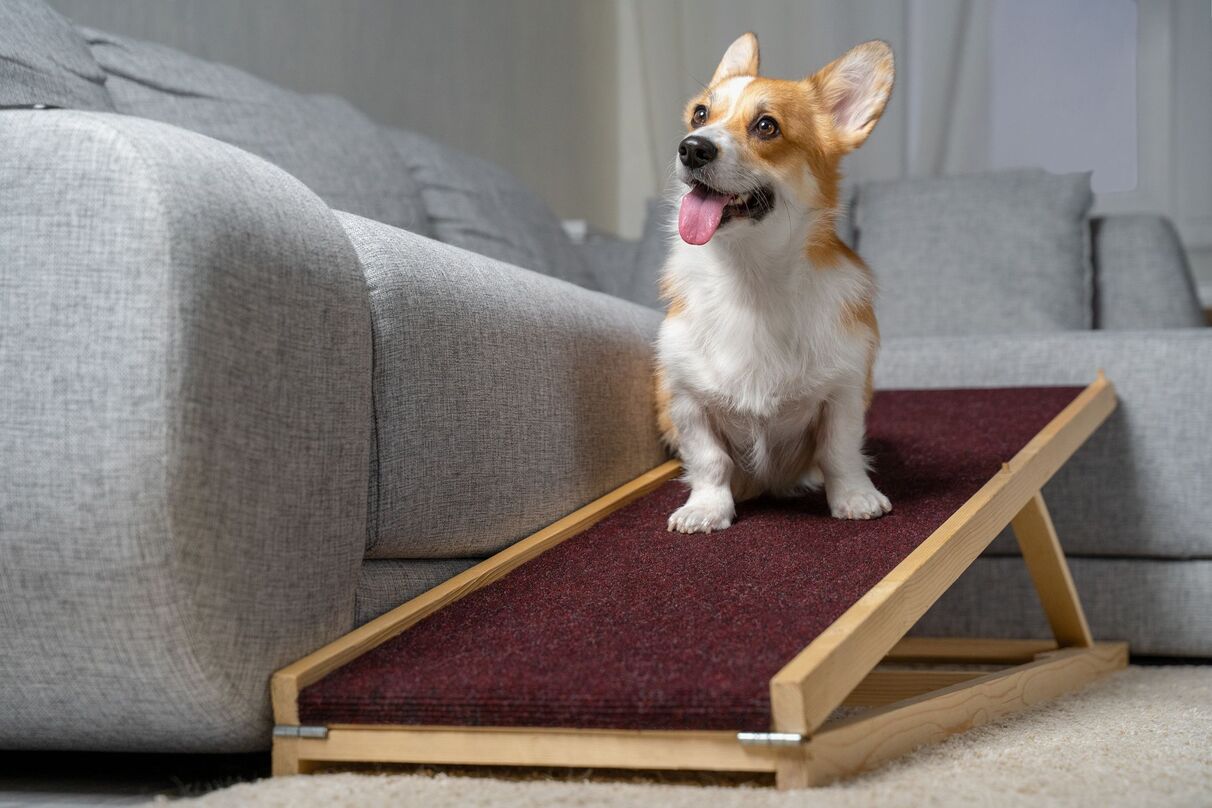Home>Health & Wellness>Common Health Issues>Muscular and Joint Health>What Is The Best Ramp For Dogs With Arthritis?


Muscular and Joint Health
What Is The Best Ramp For Dogs With Arthritis?
Modified: February 21, 2024
Discover the best ramp for dogs with arthritis to support their muscular and joint health. Find the perfect solution to aid your furry friend's mobility and comfort.
(Many of the links in this article redirect to a specific reviewed product. Your purchase of these products through affiliate links helps to generate commission for Pawsomeoldies.com, at no extra cost. Learn more)
Table of Contents
Introduction
Arthritis is a common condition that affects dogs of all ages and breeds. It is characterized by inflammation and stiffness in the joints, leading to discomfort and reduced mobility. Just like humans, dogs with arthritis require special care and support to maintain their quality of life. One crucial aspect of this care is providing them with the means to move around comfortably and safely, especially when navigating elevated surfaces such as cars, beds, or furniture.
In this article, we will explore the significance of ramps for dogs with arthritis and delve into the various types of ramps available. Additionally, we will discuss the essential factors to consider when choosing a ramp for a dog with arthritis and provide insights into some of the best ramp options currently on the market. By the end of this article, you will have a comprehensive understanding of how ramps can significantly improve the well-being of dogs with arthritis and the best options to consider for your furry companion.
Understanding Arthritis in Dogs
Arthritis, also known as osteoarthritis or degenerative joint disease, is a common condition that affects a significant number of dogs, particularly as they age. This condition involves the inflammation and degeneration of the joints, leading to pain, stiffness, and reduced mobility. While arthritis can affect any joint in a dog's body, it most commonly impacts the hips, elbows, knees, and spine.
The primary cause of arthritis in dogs is the wear and tear of the cartilage that cushions the joints. Over time, this cartilage deteriorates, resulting in friction between the bones during movement. As a result, the affected joints become inflamed, leading to discomfort and difficulty in performing regular activities such as walking, running, and jumping.
Arthritis can also be triggered by factors such as genetics, obesity, joint injuries, and certain medical conditions. Large breed dogs and those with a history of joint problems are particularly susceptible to developing arthritis. Additionally, older dogs are more prone to this condition due to the natural aging process, which can lead to the gradual breakdown of joint tissues.
The symptoms of arthritis in dogs can vary but often include stiffness, lameness, reluctance to engage in physical activities, difficulty rising from a lying position, and noticeable changes in gait. Dogs with arthritis may also exhibit signs of pain, such as whimpering or yelping when touched in the affected areas.
It's essential for dog owners to recognize the signs of arthritis and seek veterinary care promptly. Early diagnosis and intervention can significantly improve the dog's quality of life and slow the progression of the condition. Treatment options may include medication, weight management, physical therapy, and lifestyle modifications to reduce stress on the joints.
Understanding the impact of arthritis on dogs is crucial for providing them with the necessary support and accommodations to alleviate their discomfort and maintain their mobility. One such accommodation is the use of ramps, which can greatly benefit dogs with arthritis by providing them with easier access to elevated surfaces without putting excessive strain on their joints.
Importance of Ramps for Dogs with Arthritis
The significance of ramps for dogs with arthritis cannot be overstated, as these specialized aids play a crucial role in enhancing the mobility and overall well-being of arthritic dogs. Dogs affected by arthritis often experience difficulty in navigating elevated surfaces such as cars, beds, sofas, and stairs. Jumping or climbing onto these surfaces can exacerbate their joint pain and lead to further discomfort. In such scenarios, ramps serve as invaluable tools that facilitate safe and stress-free access for arthritic dogs.
Ramps provide a gentle incline for dogs to walk or ascend, eliminating the need for them to exert excessive force on their joints. This is particularly beneficial for dogs with arthritis, as it reduces the strain on their affected joints, thereby minimizing pain and discomfort. By using ramps, dogs can access elevated areas without having to engage in strenuous activities that may exacerbate their condition. This not only promotes their independence but also contributes to maintaining their physical and emotional well-being.
Moreover, ramps offer a preventive measure against potential injuries that arthritic dogs may sustain from attempting to jump onto or off elevated surfaces. The risk of falls or strains is significantly reduced when dogs have access to ramps, as they can navigate inclines at their own pace and comfort level. This is especially important for senior dogs with arthritis, as they are more susceptible to injuries and may have limited mobility compared to younger, healthier dogs.
Additionally, the use of ramps can alleviate the stress and anxiety experienced by arthritic dogs when faced with challenging surfaces. By providing a gradual and stable means of access, ramps instill a sense of confidence in dogs, encouraging them to move around more freely and independently. This can have a positive impact on their mental well-being, as it minimizes feelings of frustration or helplessness that may arise from struggling to reach elevated areas.
In essence, ramps are instrumental in improving the overall quality of life for dogs with arthritis. They promote safe and comfortable mobility, reduce the risk of injuries, and empower arthritic dogs to maintain their independence and confidence. As such, incorporating ramps into the living environment of arthritic dogs is a proactive and compassionate measure that can significantly enhance their daily experiences and contribute to their long-term health and happiness.
Types of Ramps for Dogs with Arthritis
When it comes to choosing a ramp for a dog with arthritis, it's essential to consider the specific needs and capabilities of the individual dog. There are various types of ramps designed to cater to different scenarios and environments, each offering unique features to accommodate the mobility challenges associated with arthritis. Understanding the available options can help dog owners make informed decisions based on their dog's requirements and the layout of their living space.
-
Folding Ramps: These ramps are designed for portability and convenience. They typically feature a foldable design, allowing them to be easily transported and stored when not in use. Folding ramps are ideal for providing access to vehicles, such as cars or SUVs, making travel with an arthritic dog more manageable. The ability to fold and unfold the ramp as needed ensures that dogs with arthritis can navigate in and out of vehicles with minimal strain on their joints.
-
Telescoping Ramps: Telescoping ramps offer adjustable length options, providing flexibility in accommodating various heights and inclines. This type of ramp is particularly useful for accessing different elevated surfaces, such as beds or couches, as it can be adjusted to match the specific height requirements. The telescoping mechanism allows for easy customization, ensuring that arthritic dogs can access elevated areas comfortably and safely.
-
Ramps with Non-Slip Surfaces: These ramps are equipped with non-slip surfaces, such as textured materials or grip tape, to provide secure footing for dogs, especially those with mobility issues. The non-slip feature is crucial for arthritic dogs, as it enhances stability and confidence when ascending or descending the ramp. This type of ramp is suitable for indoor and outdoor use, offering traction and support to minimize the risk of slips or falls.
-
Ramps with Adjustable Angles: Ramps with adjustable angles are designed to accommodate dogs with varying mobility capabilities. By altering the incline of the ramp, dog owners can create a customized access point that suits their arthritic dog's comfort level. This feature is beneficial for dogs with arthritis, as it allows for gradual and gentle inclines, reducing the strain on their joints while navigating the ramp.
-
Ramps with Side Rails: Some ramps are equipped with side rails or raised edges to provide additional security and guidance for arthritic dogs. The presence of side rails offers a sense of reassurance and prevents dogs from veering off the ramp during ascent or descent. This feature is particularly beneficial for dogs with balance or coordination challenges, ensuring that they can move safely and confidently along the ramp.
Understanding the diverse range of ramps available for dogs with arthritis enables dog owners to select the most suitable option based on their dog's specific needs and the intended usage. By considering factors such as portability, adjustability, non-slip surfaces, angles, and safety features, dog owners can make informed choices that promote the comfort and well-being of their arthritic canine companions.
Factors to Consider When Choosing a Ramp
When selecting a ramp for a dog with arthritis, several crucial factors should be taken into account to ensure that the chosen ramp effectively meets the specific needs of the arthritic dog and seamlessly integrates into the living environment. By carefully considering these factors, dog owners can make informed decisions that prioritize the safety, comfort, and mobility of their canine companions.
-
Size and Weight Capacity: The size and weight capacity of the ramp are paramount considerations. The ramp should be appropriately sized to accommodate the dog's breed and size, ensuring that it provides ample space for comfortable movement. Additionally, the weight capacity of the ramp must align with the dog's weight to guarantee stability and safety during use.
-
Portability and Storage: For dog owners who require a ramp for travel or occasional use, portability and ease of storage are essential factors. Portable ramps should be lightweight, foldable, or telescoping, allowing for convenient transportation and compact storage when not in use. This is particularly beneficial for providing arthritic dogs with consistent access to elevated surfaces in various locations.
-
Surface Traction and Grip: The ramp's surface should offer superior traction and grip to prevent slipping and ensure secure footing for arthritic dogs. Non-slip surfaces, such as textured materials or grip tape, are crucial for promoting stability and confidence during ascent and descent. This feature is especially important for dogs with mobility challenges, as it minimizes the risk of falls or accidents.
-
Adjustability and Incline: Ramps with adjustable lengths or angles provide versatility in accommodating different heights and inclines, catering to the specific needs of arthritic dogs. The ability to customize the ramp's incline ensures that dogs can navigate it comfortably and safely, minimizing stress on their joints. This feature is particularly beneficial for accessing a variety of elevated surfaces within the home environment.
-
Durability and Stability: The ramp should be constructed from durable materials capable of supporting the dog's weight and providing long-term stability. Sturdy construction and reliable support mechanisms are essential for ensuring the safety and confidence of arthritic dogs as they utilize the ramp. Additionally, the ramp's stability is crucial for preventing wobbling or shifting during use, minimizing the risk of accidents.
-
Safety Features: Consideration should be given to additional safety features, such as side rails or raised edges, which provide guidance and reassurance for arthritic dogs as they navigate the ramp. These features enhance the overall security and prevent dogs from veering off the ramp, promoting a sense of confidence and minimizing the risk of mishaps.
By carefully evaluating these factors, dog owners can make well-informed decisions when choosing a ramp for their arthritic canine companions. Prioritizing the specific needs and capabilities of the dog, as well as the intended usage of the ramp, ensures that the selected ramp effectively enhances the dog's mobility and overall well-being.
Best Ramp Options for Dogs with Arthritis
When it comes to selecting the best ramp for a dog with arthritis, several options stand out for their exceptional design, functionality, and suitability for addressing the specific mobility needs of arthritic dogs. These ramps have been carefully crafted to provide safe and comfortable access to elevated surfaces, ensuring that dogs with arthritis can navigate their living environments with ease and confidence.
-
PetSafe Happy Ride Extra Long Telescoping Dog Ramp: This telescoping ramp offers an extended length, making it an ideal choice for accessing higher surfaces such as SUVs or trucks. Its adjustable design allows for customization based on the specific height requirements, ensuring that arthritic dogs can comfortably and safely enter and exit vehicles without exerting excessive strain on their joints.
-
Solvit Deluxe Tri-Scope Dog Ramp: Known for its sturdy construction and tri-fold design, this ramp provides a compact and portable solution for arthritic dogs. The high-traction surface and adjustable incline cater to dogs with varying mobility capabilities, while the durable build ensures stability and support during use. Its portability makes it a versatile option for both indoor and outdoor settings.
-
Pet Gear Free-Standing Extra Wide Carpeted Ramp: This free-standing ramp offers a wide and carpeted surface, providing exceptional traction and comfort for arthritic dogs. Its gentle incline and sturdy structure make it suitable for accessing beds, couches, or other elevated surfaces within the home. The free-standing feature eliminates the need for attachment, offering flexibility in placement and usage.
-
Gen7Pets Natural-Step Ramp for Pets: Engineered with a unique artificial turf surface, this ramp prioritizes comfort and secure footing for arthritic dogs. The soft and supportive surface minimizes joint impact and provides a natural feel for dogs as they ascend or descend. The lightweight and foldable design make it a convenient option for travel and on-the-go use.
-
PetSTEP Original Folding Pet Ramp: Renowned for its durability and versatility, this folding ramp offers a non-slip rubberized surface and a single-hand fold mechanism for effortless storage and transportation. Its rugged construction and superior weight capacity make it suitable for dogs of various sizes, ensuring reliable support and stability during use.
These best ramp options for dogs with arthritis have been thoughtfully designed to address the unique mobility challenges faced by arthritic dogs. By incorporating features such as adjustable inclines, non-slip surfaces, portability, and sturdy construction, these ramps provide practical solutions for enhancing the accessibility and comfort of arthritic dogs within their living environments. When selecting a ramp, it's essential for dog owners to consider the specific needs and capabilities of their arthritic canine companions, ensuring that the chosen ramp aligns with their individual requirements and promotes safe and stress-free mobility.
Conclusion
In conclusion, ramps play a pivotal role in improving the quality of life for dogs with arthritis by providing them with safe and comfortable access to elevated surfaces. The significance of ramps for arthritic dogs cannot be overstated, as these specialized aids alleviate the strain on their joints, reduce the risk of injuries, and empower them to maintain their independence and confidence. By incorporating ramps into the living environment of arthritic dogs, owners can proactively enhance their canine companions' daily experiences and contribute to their long-term health and happiness.
Understanding the diverse range of ramps available for dogs with arthritis enables dog owners to select the most suitable option based on their dog's specific needs and the intended usage. Factors such as portability, adjustability, non-slip surfaces, angles, and safety features should be carefully considered when choosing a ramp to ensure that it effectively meets the specific needs of the arthritic dog and seamlessly integrates into the living environment.
Furthermore, the best ramp options for dogs with arthritis have been thoughtfully designed to address the unique mobility challenges faced by arthritic dogs. These ramps offer practical solutions for enhancing the accessibility and comfort of arthritic dogs within their living environments, incorporating features such as adjustable inclines, non-slip surfaces, portability, and sturdy construction.
In essence, the use of ramps significantly improves the overall well-being of dogs with arthritis, promoting safe and comfortable mobility, reducing the risk of injuries, and empowering arthritic dogs to maintain their independence and confidence. As such, integrating ramps into the daily lives of arthritic dogs is a proactive and compassionate measure that can significantly enhance their mobility and contribute to their overall happiness and health.














